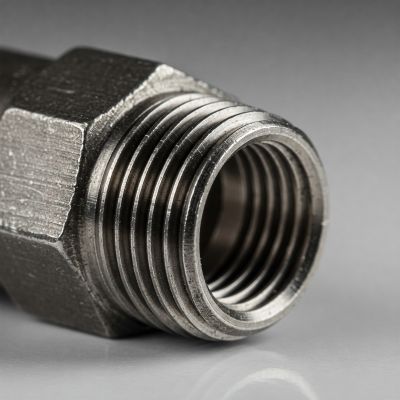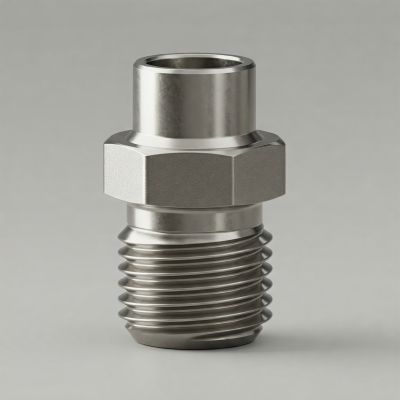Pipe threads are essential components in industrial applications, ensuring secure and reliable connections for fluid and gas transfer. Choosing the right type of thread is critical for preventing leaks, maintaining system efficiency, and ensuring safety.
Two commonly used thread types are NPT (National Pipe Taper) and NPTF (National Pipe Taper Fuel). While they may look similar, they have distinct characteristics that determine their suitability for specific applications. This article explains the key differences between NPT and NPTF threads, their applications, and why selecting the correct thread type is important.
Understanding NPT and NPTF Threads
NPT (National Pipe Taper) Thread
NPT threads are tapered pipe threads that require additional sealing compounds, such as Teflon tape or pipe dope, to prevent leaks. They are widely used in plumbing, air, and fluid systems due to their simple installation and widespread availability.
NPTF (National Pipe Taper Fuel) Thread
NPTF threads, also known as dry-seal threads, are designed to form a leak-proof mechanical seal without the need for sealants. This is achieved through thread deformation, which creates a tighter and more secure fit.
Key Characteristics of Each Thread Type
➡️ NPT Threads:
1. Requires sealants to prevent leaks.
2. Standard taper with looser tolerances.
3. Commonly used in general-purpose plumbing and fluid transport.
➡️ NPTF Threads:
1. Forms a dry-seal without additional sealants.
2. Tighter tolerances with controlled interference fit.
3. Preferred for high-pressure and fuel system applications.
Why These Threads Are Used in Fluid and Gas Systems
Both NPT and NPTF threads are widely used in fluid and gas systems because of their tapered design, which allows for better sealing under pressure. However, the choice between the two depends on the application’s need for a dry-seal or the acceptance of additional sealing compounds.
Key Differences Between NPT and NPTF
Sealing Mechanism
➡️ NPT Threads: Require thread sealants such as Teflon tape or pipe dope to ensure a leak-free connection.
➡️ NPTF Threads: Achieve a leak-proof seal through precise thread deformation, eliminating the need for external sealants.
Thread Deformation and Fit
➡️ NPT Threads: Engage with a looser fit, leaving potential gaps that require sealant.
➡️ NPTF Threads: Have a controlled interference fit, where the male and female threads deform slightly upon tightening, closing any gaps for a secure seal.
Tolerance and Precision
➡️ NPTF threads are manufactured to stricter tolerances than NPT threads, ensuring a precise and consistent fit.
Applications and Suitability
➡️ NPT is preferred for:
1. General plumbing applications.
2. Low-pressure air and water lines.
3. Non-critical fluid transport.
➡️ NPTF is preferred for:
1. High-pressure hydraulic and fuel systems.
2. Automotive and industrial machinery applications.
3. Situations where leak prevention is critical without sealants.
Can NPT and NPTF Threads Be Used Together?
While NPT and NPTF threads share similar dimensions, they are not fully interchangeable due to their different sealing mechanisms.
Compatibility Issues
➡️ NPT male threads may fit into NPTF female threads, but they may not create a proper dry-seal.
➡️ NPTF male threads in NPT female threads could result in leaks since the female threads may not be precise enough for proper deformation.
Risks of Mixing NPT and NPTF Threads
➡️ Potential for leaks in high-pressure applications.
➡️ Reduced mechanical strength due to improper thread engagement.
➡️ Inconsistent sealing performance over time.
When Can They Be Used Interchangeably?
NPT and NPTF threads can sometimes be used together in low-pressure applications where absolute leak-proof performance is not critical. However, for fuel and high-pressure systems, using the correct thread type is essential.
NPT and NPTF Thread Standards and Specifications
Industry Standards
➡️ NPT Threads: Governed by ANSI/ASME B1.20.1
➡️ NPTF Threads: Governed by ANSI/ASME B1.20.3
Key Dimensional Tolerances and Specifications
➡️ NPTF threads have tighter pitch diameter tolerances than NPT.
➡️ Proper engagement of NPTF threads ensures interference fit and dry-seal.
How to Verify Compliance with Industry Standards
➡️ Use thread gauges to check dimensions.
➡️ Conduct pressure testing in critical applications.
How to Identify NPT and NPTF Threads
Visual and Dimensional Differences
➡️ NPT Threads: Have slightly looser fit and require sealant.
➡️ NPTF Threads: Appear sharper and fit more tightly.
Tools for Accurate Identification
➡️ Thread pitch gauges to determine thread pitch.
➡️ Micrometers and calipers for measuring thread diameter.
Common Mistakes in Thread Identification
➡️ Assuming NPT and NPTF are interchangeable.
➡️ Not using proper measuring tools.
➡️ Relying solely on visual inspection instead of using thread gauges.
Benefits of Using the Right Thread Type
For NPT:
➡️ Easier to assemble and disassemble.
➡️ Works well with standard plumbing applications.
For NPTF:
➡️ Provides a leak-free connection without sealants.
➡️ Reduces maintenance and enhances system reliability.
Cost and Maintenance Considerations
➡️ Using the correct thread type reduces repair costs.
➡️ NPTF eliminates the need for additional sealants, saving time and effort.
Common Applications of NPT and NPTF Threads
Industries Using NPT Threads
➡️ Plumbing and water systems
➡️ Low-pressure air and fluid lines
➡️ General-purpose piping applications
Industries Using NPTF Threads
➡️ Fuel and gas systems
➡️ High-pressure hydraulic applications
➡️ Automotive and industrial machinery
Best Practices for Working with NPT and NPTF Threads
Proper Installation Techniques
➡️ Use appropriate torque values to avoid over-tightening.
➡️ Before assembling, make sure the threads are clear of debris and clean.
Recommended Tools for Threading and Sealing
➡️ Threading dies and taps for creating precise threads.
➡️ Sealants and lubricants (only when working with NPT threads).
Avoiding Common Errors
➡️ Mismatching thread types leading to improper sealing.
➡️ Over-tightening causing thread damage.
➡️ Not verifying thread standards before installation.
Conclusion
Key Takeaways
➡️ NPT requires sealants, while NPTF creates a dry-seal through thread deformation.
➡️ They are not fully interchangeable due to differences in tolerances and sealing mechanisms.
➡️ Choosing the right thread type ensures system reliability and prevents costly leaks.
Final Recommendations
➡️ Always verify thread specifications before installation.
➡️ Use proper measurement tools for accurate identification.
➡️ Follow best practices to maintain leak-free and reliable connections.
Post time: Mar-05-2025



